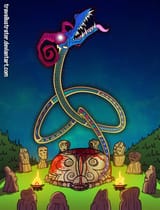Search Results
7/1/2025, 7:44:17 AM
>>509192256
>Such sidhe mounds were regarded as entrances to the Celtic otherworld lands, magical lands of perpetual youth, feasting and happiness. This is a far cry from the picture we are presented with in the ancient poems of Crom Cruaich
>Sacred Mounds or High Places
>In Wales, the gorsed was a gathering place on the top of sacred mounds or high places for the giving of judgements. The gorsed of Arberth, in South Wales, is mentioned in the ancient sagas of the Mabinogi. It is said that no-one ever ascended the hill without either receiving wounds, or seeing a miracle, another reference to the duality of positive and negative found in mythology. The gorsed was held in the open air, around a circle of stones, with a larger stone in the middle. The image of Crom and his stone idols comes to mind once again. This ancient tradition of gathering on hill summits was carried on well into Christian times, with Parliament hills or Law hills to be found all over Scotland. On the Isle of Man the Manx parliament still assembles every midsummer on Tynwald hill, to read out the laws of the land to the people. In Ireland, thousands of pilgrims climb to the summit of Croagh Padraig in Co. Mayo every year, out of respect for their saint. In the poem from the Book of Leinster, we are told that:
>Since the rule
>of Herimon, the noble man of grace
>There was worshipping of stones
>Until the coming of good Patrick of Macha
>Tighearnmas the Fifth Milesian King
>Folklore has much to say about this worshipping of stones and this is a huge subject in its own right. Mention is made in the Brehon Laws of Ailche Adhartha or the Stones of Adoration. What I am really interested in here is the mention of Herimon. His name is usually written as Eremon, and he was one of the first sons of Mil who came to Ireland, and took the kingship of the land thereafter
>Such sidhe mounds were regarded as entrances to the Celtic otherworld lands, magical lands of perpetual youth, feasting and happiness. This is a far cry from the picture we are presented with in the ancient poems of Crom Cruaich
>Sacred Mounds or High Places
>In Wales, the gorsed was a gathering place on the top of sacred mounds or high places for the giving of judgements. The gorsed of Arberth, in South Wales, is mentioned in the ancient sagas of the Mabinogi. It is said that no-one ever ascended the hill without either receiving wounds, or seeing a miracle, another reference to the duality of positive and negative found in mythology. The gorsed was held in the open air, around a circle of stones, with a larger stone in the middle. The image of Crom and his stone idols comes to mind once again. This ancient tradition of gathering on hill summits was carried on well into Christian times, with Parliament hills or Law hills to be found all over Scotland. On the Isle of Man the Manx parliament still assembles every midsummer on Tynwald hill, to read out the laws of the land to the people. In Ireland, thousands of pilgrims climb to the summit of Croagh Padraig in Co. Mayo every year, out of respect for their saint. In the poem from the Book of Leinster, we are told that:
>Since the rule
>of Herimon, the noble man of grace
>There was worshipping of stones
>Until the coming of good Patrick of Macha
>Tighearnmas the Fifth Milesian King
>Folklore has much to say about this worshipping of stones and this is a huge subject in its own right. Mention is made in the Brehon Laws of Ailche Adhartha or the Stones of Adoration. What I am really interested in here is the mention of Herimon. His name is usually written as Eremon, and he was one of the first sons of Mil who came to Ireland, and took the kingship of the land thereafter
Page 1
